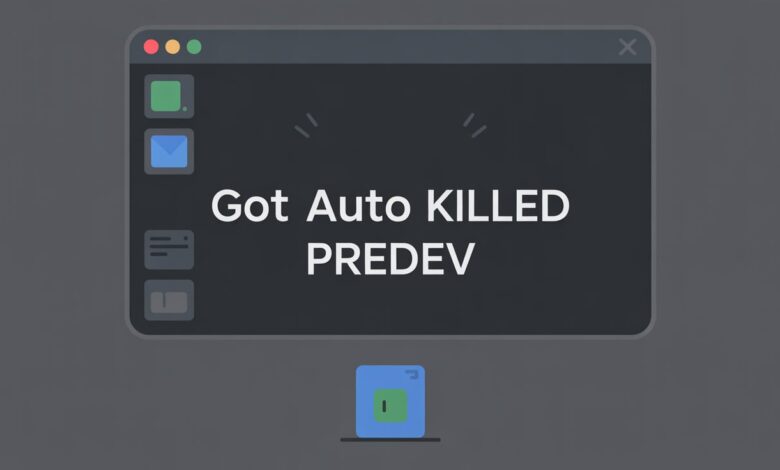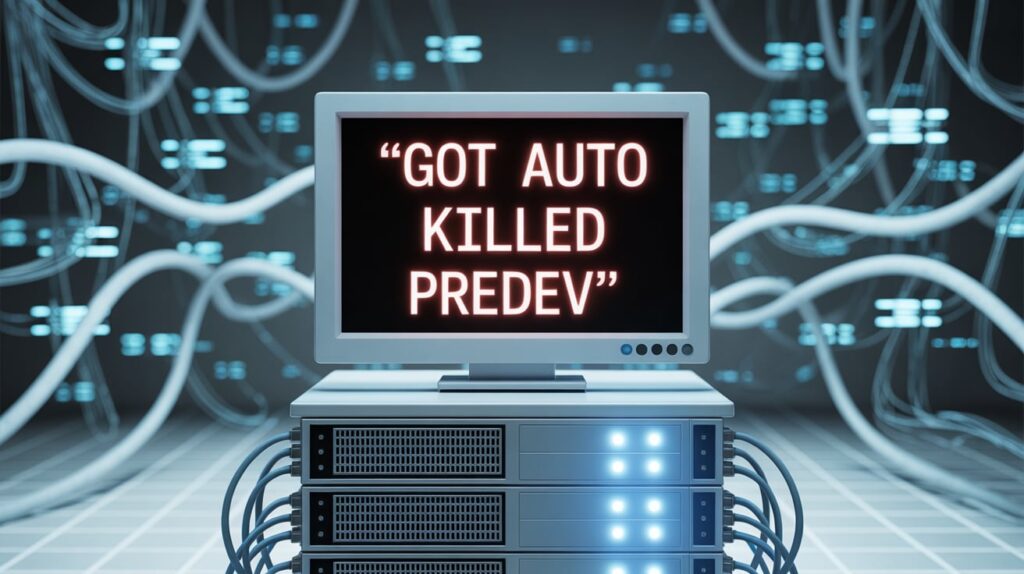Got Auto Killed Predev: Simple Guide to Understand and Fix the Error in 2025

If you ever see the message got auto killed predev, it can feel like a mystery. It looks scary. It can stop your project from starting. But it is not magic. It is a sign from the system that a pre-development step was stopped by the computer itself.
In plain words, “got auto killed predev” usually means a predev script or task was shut down by the operating system. The system does this to protect itself. When a task uses too many resources or behaves in a risky way, the OS may kill it before it can do more harm. This is the short version of the problem.
What the message really means
The phrase has two parts. “Auto killed” means the system terminated a process automatically. “Predev” points to a step that runs before the main development work starts — for example a build script, setup task, or a test runner. When that early step is killed, your build or server may not finish starting.
This is not always a bug in your code. Often it is the system saying one of its limits was reached. It could be about memory. It could be about permissions. It could be about running inside a container with tight limits. Knowing this helps you stop guessing and start checking the right things.
Why it happens — the usual causes
The most common cause is running out of memory. Big build tools or heavy tasks can use a lot of RAM. If the system runs out of free memory, the kernel may pick a process to kill. That process can be the predev script. This is a frequent reason for seeing got auto killed predev.
Another cause is a script that runs too long or uses the CPU in a bad way. An accidental infinite loop or heavy computation can make the system decide the task is unsafe. Then the task gets killed. Permissions problems can also make a script fail and appear to be “auto killed.” If a process tries to access a protected area without permission, the OS or container manager may stop it.
Containers and CI pipelines often add one more layer. They set resource limits with cgroups, ulimits, or container configs. If your predev step crosses those limits, the environment will stop it to avoid taking down other jobs. Finally, missing or broken dependencies can make a step hang or crash and the system may kill it to keep things stable.
How to spot it — quick checks you can do now

Watch the symptoms. Your dev server may fail to start. Dependencies may not install. The logs may show the exact phrase got auto killed predev or a closely related system message. These signs tell you the shutdown happened early, during setup.
Check the system and kernel logs next. On Linux, look for OOM (out of memory) messages in dmesg or journalctl -k. In containers, check the container logs and the host’s system logs. These logs often say why the OS killed a process. If you see an OOM kill entry, memory is the likely cause. If you see permission errors or timeouts, that points elsewhere.
A small story to make it real
I once ran into this during a tight deadline. A predev build kept dying with the same vague message. I first thought the tool had a bug. After a few false starts, I checked the logs. The kernel had picked the build process as the thing to kill. The server had run out of memory because two other heavy tasks were running at the same time. After that, the fix was obvious. I changed how and when tasks ran. The error stopped.
Think of it like trying to cook three big meals on one small burner. The stove will overheat or a fuse will trip. The system does the same when too many heavy tasks run at once. Fixing the order or giving more resources usually helps.
Step 1: Check Your Memory
The first thing to do is check if your system is running out of memory. This is one of the main reasons for the “got auto killed predev” error.
Open your system monitor or task manager and see how much memory your computer is using. If it’s close to 100%, your predev process might be getting shut down because there isn’t enough memory left.
Try closing other programs or heavy apps that you’re not using. If you’re working on a server or in a container, increase the memory limit. You can also upgrade your system’s RAM if it’s too low for your work.
For example, if you’re using Node.js, you can set a memory limit by running:
export NODE_OPTIONS="--max-old-space-size=4096"
This gives Node more memory space to work with.
Step 2: Look at the Logs
Logs can tell you the real story behind the error. Check both your project logs and your system logs.
If you’re on Linux, you can use:
dmesg | grep -i "killed process"
This command will show if your process was killed by the system.
If you see an “Out of Memory” message, you’ll know that low memory caused the got auto killed predev error. But if it shows permission or timeout errors, you’ll need to fix those instead.
Reading logs might sound boring, but it’s like reading a diary that tells you what went wrong and when.
Step 3: Check Your Script or Predev Task
Sometimes, the predev script itself causes the issue. Maybe there’s a loop that never ends or a command that takes too long to finish.
Go through your script step by step. Try commenting out one line at a time and run it again. This will help you find which part is causing the trouble.
You can also add simple console logs or print statements to see where it stops. Once you find the problem line, you can rewrite or remove it.
A quick story: a developer once kept seeing this same error every time they ran “npm run predev.” After checking, they found a missing dependency that made the script hang forever. Once they installed it properly, the issue disappeared.
Step 4: Watch for Permission Problems

If you’re working on Linux or macOS, permission issues can also trigger the got auto killed predev error. The system might stop a script that tries to access files or folders without the right permission.
Use:
chmod +x yourscript.sh
to give your script the right permission.
Also, check that your user has access to all folders that the script uses. It’s a small step but often fixes big problems.
Step 5: Update Dependencies and Tools
Outdated tools or packages can cause strange problems. Make sure your development tools are updated. Run:
npm update
or
yarn upgrade
if you’re using those.
Sometimes, the got auto killed predev error happens because an old dependency has memory leaks or broken code. Updating them can fix it fast.
Step 6: Adjust Limits in Containers or CI Pipelines
If you’re running your project inside Docker, Kubernetes, or a CI/CD system, those environments have resource limits.
For example, Docker might be giving your container only 512MB of memory. When your predev task needs more, it gets killed.
You can fix this by raising the limits in your configuration. For Docker, you can use:
docker run -m 2g your-container
to give it 2GB of memory.
Always make sure your environment gives enough resources for your build or predev tasks.
Step 7: Split Heavy Tasks
If your predev process runs many heavy tasks at once, try splitting them. Run smaller parts step by step instead of everything together.
This keeps your system from being overloaded and reduces the chance of seeing the got auto killed predev error again.
For example, instead of running a script that builds, tests, and deploys at once, break it into three smaller commands.
Final Thoughts
The “got auto killed predev” error may look scary at first, but it’s often just a sign that your system needs a little help. Once you know where to look — memory, scripts, permissions, or limits — you can fix it easily.
Always check logs first. They tell you what really happened. Then take one step at a time to solve it.
If you face it again in the future, you’ll know it’s not a random problem. It’s your system’s way of saying, “Hey, I need more space or time.”
By following these steps, you can keep your projects running smoothly and avoid seeing “got auto killed predev” ever again.



